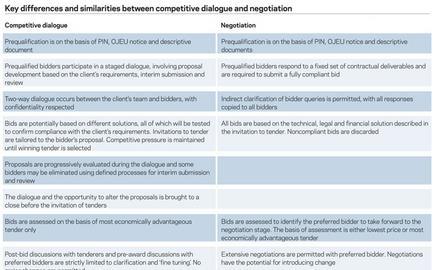If your client’s public-sector scheme needs bidder input during procurement, then competitive dialogue is likely to be the best option. Now that some projects have been let using the process, Simon Rawlinson of Davis Langdon reviews the lessons learned
01 Introduction
Competitive dialogue is a public-sector tendering option that allows for bidders to develop alternative proposals in response to a client’s outline requirements. Only when their proposals are developed to sufficient detail are tenderers invited to submit competitive bids. The aims are to increase value by encouraging innovation and to maintain competitive pressure in bidding for complex contracts.
Competitive dialogue was designed to facilitate all manner of complex purchases, from PFI hospitals to weapons systems, and its use on complex deals such as Building Schools for the Future (BSF) will have further implications for the attraction of PPP/PFI opportunities in the contractor marketplace.
For the client, competitive dialogue makes it easier to confirm that “all necessary elements” are in place before bids are submitted, resulting in more robust tenders. Active dialogue should prevent the possibility of misinterpretation by either the tenderer or the client and hence cost escalation later in the contract. For bidders, the process provides better information flow, together with the opportunity to test the client’s requirements through a progressive development of their proposal.
Effective procurement will identify a project’s target market and package up the opportunity to appeal to that market. It will also focus on securing a deliverable and affordable solution that best meets the client’s needs, and providing a firm contractual basis against which delivery and performance can be assessed.
Where unfamiliar procurement procedures such as competitive dialogue are introduced, clients should aim to make their project as marketable as possible by securing the interest of bidders best placed to deliver it.
02 Competitive dialogue and negotiations
Competitive dialogue was established in article 29 of the Public Sector Procurement Directive 2004 and in the UK by the Public Contracts Regulations (2006). It was added to the arsenal of procurement procedures to provide an alternative to the growing use of negotiation on complex projects, and to make better use of the private sector’s role in delivering innovation.
The use of competitive dialogue is expected on projects where the client is able to state its requirement at the outset, but either cannot or does not want to define what the solution should be. This need to keep options open can stem from technical, legal or financial issues such as alternative design solutions, risk allocation arrangements and so on.
At first glance competitive dialogue appears to require less preparation by the client because the development of solutions is carried out by the bidders, but bodies such as the Office of Government Commerce (OGC) advise that thorough preparation be undertaken, so that the client can fully brief participants and respond appropriately to bidders’ proposals during the dialogue.
Despite the substantial difference in process between negotiation and competitive dialogue, the outcome should be similar: an affordable and compliant preferred bid on which the parties can proceed to contract.
The benefits from competitive dialogue are primarily related to the more detailed testing of the preferred proposal. In practice, the application of competitive dialogue has also revealed the following benefits:
- Both the client and the delivery partner have greater confidence in the quality of the solution and the submission, particularly if it has been progressively tested during the dialogue process.
- Competitive dialogue does generate alternative design proposals, giving greater potential for added value in project delivery.
- The iterative process of solution development fits well with the development of solutions to the complexities of PPP deals such as BSF, which involve issues of educational policy, land swaps, design and facilities management, hard and soft service delivery and so on.
Dialogue is, however, an extended process. A typical three-stage dialogue, involving three sets of deliverables and assessments prior to the closure of the dialogue could take around 80 weeks, excluding the client’s initial development work. Total costs are also higher, with three bidders incurring significant bid costs which, in most cases, the client is unlikely to pay for.
Clients also need to be aware that there is no binding offer on the table during the process until final bids are requested. Although the overall objective of the dialogue is to progressively develop proposals that are compliant and affordable, there is no discipline on a tenderer other than the competitive pressure from other bidders.
03 Practical steps to deliver effective competitive dialogue
Prequalification Competitive dialogue does not have specific requirements at prequalification. Advisory bodies such as OGC and 4Ps recommend that it examine a wider range of non-technical issues related to bidders’ ability to complete the dialogue.
Warming the market In addition to the OJEU process, clients should invest in attracting bidders of the right calibre. The descriptive document is a key sales tool, describing only the requirement and the client’s priorities, together with details of the dialogue and the assessment process. Bidders’ conferences also have a useful role.
Staging the dialogue process Staged assessment is important to attract a wide range of proposals and to reduce the number of participants early to give tenderers a fair chance of success. De-selection has to be built into the process from the outset and will add 4-6 weeks per stage to the procurement timetable.
Confidentiality issues A tenderer’s opportunity to develop solutions as part of the dialogue is one of the benefits of the process, but the requirement to protect confidentiality introduces issues of discipline on the client’s team. With negotiation, Q&As are typically managed on a gatekeeper basis, often answered by reference to the specification, with the priority being to preserve a level playing field. Using competitive dialogue, the client will be actively engaged with multiple tenderers, which could result in accidental exchange of valuable ideas. Lawyers recommend that clients adopt formal confidentiality policies that will establish what information should be shared. Confidentiality policies are also a good protection against challenge under the EU procurement process.
Resource requirements Competitive dialogue requires detailed development by multiple bidders. On the client side, the management and resourcing of the dialogue has to be considered, together with the production of bespoke ITT documents for the proposals. Although the client is expected to benefit from faster financial close and a better, more secure solution, bidders are exposed to a greater risk of unrecoverable expenditure. There are growing demands for contributions to bidding costs, particularly where bidders are involved in multiple dialogues with the same client. The resource commitment involved is likely to increase the risk of challenge to procurement decisions, further encouraging the adoption of consistent, best practice procurement policy.
Managing the dialogue process Momentum can be helped by the client’s planning of sessions, identifying the topics, those involved, the outputs required and so on.
Stakeholder engagement Competitive dialogue requires client engagement in design, contracts, service standards and payment mechanisms. The client must be equipped to respond promptly to proposals or changes. Good public sector procurement is also based on stakeholder engagement, so decision-making bodies are needed that can represent the full client body, have the expertise to respond to the issues raised and have the authority to confirm decisions in compliance with the programme.
Consistent assessment Assessment schemes for public sector projects must reflect all the criteria required to identify the most economically advantageous tender. Competitive dialogue introduces the need to assess different solutions using the same criteria. Well-defined assessment schemes should provide the most consistent assessment – an important factor should the award be subject to post-award challenge. As there is so little opportunity for adjustment to proposals post-tender, it is important that the assessment criteria and the weightings applied do not favour one aspect of the proposals. With a poorly constructed assessment schema, clients run the risk of having to award the contract to sub-optimal bids. Use of the schema during the dialogue stage should enable the assessment to be fine-tuned ahead of final tenders.
04 The indicative competitive dialogue process
This flowchart shows the key stages of the competitive dialogue process. Different public bodies use different terms to describe outputs and notices. The staged process described here conforms to the OGC’s model of progressive selection.
Downloads
The indicative competitive dialogue process
Other, Size 0 kb























2 Readers' comments